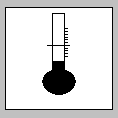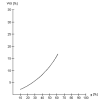| Apples, dried | [German version] |
Table of contents |
|
| General: | ||
| Product information | ||
| Packaging | ||
| Transport | ||
| Container transport | ||
| Cargo securing | ||
Product information
Product name
| German | Äpfel, getrocknet (Ringäpfel) |
| English | Apples, dried (apple rings) |
| French | Pommes séchées |
| Spanish | Manzanas secados |
| Scientific | Malus domestica |
| CN/HS number * | 0813 30 00 |
(* EU Combined Nomenclature/Harmonized System)
Product description
Dried apples are peeled, cored and dried slices of the fruit of the apple tree, which is a member of the rose family (Rosaceae). They are a kind of dried fruit and are primarily traded as apple rings.
Further information about apples may be found on the Apples product page.
Quality / Duration of storage
Yellowing of the apples is usually the result of excessive sulfurization.
If dried apples are transported or stored at temperatures of 0 – 7°C, they have a storage life of up to 1 year.
Intended use
Dried apples are mainly eaten raw and used as an ingredient in mixed fruit, muesli and trail mixes.
Figures
(Click on the individual Figures to enlarge them.)
 Figure 1 |
 Figure 2 |
Countries of origin
This Table shows only a selection of the most important countries of origin and should not be thought of as exhaustive.
| Europe | Italy, Netherlands, Turkey |
| Africa | |
| Asia | China |
| America | Argentina, Canada, USA |
| Australia | Australia |
Back to beginning
Packaging
Dried apples are packaged in, among other things, cartons, boxes or also in bags.
When packaged in corrugated or millboard cartons, the product should be transported on pallets. The packaging size should be so selected that the dimensions of the individual area modules or area module multiples are conformed to the conventional pallet sizes (800×1200 mm and 1000×1200 mm) and cargo units may thus be produced.
Back to beginning
Transport
Symbols
 General cargo |
 Temperature-controlled |
Means of transport
Ship, railroad, truck
Container transport
Standard containers / refrigerated containers are used, subject to compliance with lower limits for water content of goods, packaging and container flooring.
Cargo handling
Since the packages are sensitive to impact, appropriate care must be taken during cargo handling.
In damp weather (rain, snow), the cargo must be protected from moisture, since this may lead to mold, rot, fermentation and tackiness.
Stowage factor
| 3.10 m³/t (flat linen fabric bags, 50 kg) [1] | |
| 2.55 m³/t (jute bags, 50 kg) [1] | |
| 2.41 – 2.55 m³/t (cartons) [14] |
Stowage space requirements
Cool, dry, good ventilation if required
Segregation
Fiber rope, thin fiber nets, matting, jute coverings. Marker pen, oil crayon for cartons.
Cargo securing
In order to ensure safe transport, the cargo must be stowed and secured in the means of transport in such a manner that it cannot slip or shift during transport. If loss of volume and degradation of quality are to be avoided, the packages must not be damaged by other articles or items of cargo.
Back to beginning
Risk factors and loss prevention
RF Temperature
Dried apples require particular temperature, humidity/moisture and possibly ventilation conditions (SC VI) (storage climate conditions).
Precise details should be obtained from the consignor as to the storage temperature to be maintained.
| Designation | Temperature range | Source |
|---|---|---|
| Favorable travel temperature | 5 – 20°C | [1] |
| 0 – 7°C | [4] |
0 – 7°C is the optimum temperature range. In this case, the apples have a storage life of up to 1 year.
At temperatures < 10°C, possible mite growth is inhibited while at temperatures < -2°C there is a risk of spoilage.
Chemical reactions proceed rapidly at temperatures > 25 – 30°C. As a result, the apple rings become darker in color and their flavor is often impaired.
The product should not be stored close to heat sources as this may result not only in syrup formation, but also in drying out and candying.
Back to beginning
RF Humidity/Moisture
Dried apples require particular temperature, humidity/moisture and possibly ventilation conditions (SC VI) (storage climate conditions).
Precise details should be obtained from the consignor as to the relative humidity to be maintained.
| Designation | Humidity/water content | Source |
| Relative humidity | 60 – 70% | [1] |
| Water content | 20 – 24% | [1] |
| Maximum equilibrium moisture content | 70% | [1] |
At relative humidities > 70%, dried apples have a tendency to become tacky, moldy and support yeast growth. At relative humidities < 60%, the apples become tough and hard, so making them unsuitable for eating raw.
The sorption isotherm for dried apple slices rises steeply, which indicates the strong hygroscopicity of this dried fruit.
 Figure 3 |
Avoid exposure to moisture (seawater, rain, condensation water), as the product is strongly hygroscopic and moistening may result in swelling and mold growth. Contact with water may also initiate a fermentation process in dried fruit. Once initiated, such a fermentation process is irreversible and, despite starting from a single point, finally spreads throughout the entire cargo.
In order to prevent wetting of the product by sweat from hold or container surfaces, it should be protected with dunnage .
Back to beginning
RF Ventilation
Dried apples require particular temperature, humidity/moisture and possibly ventilation conditions (SC VI) (storage climate conditions).
If the product is at „shipping dryness“, i.e. if there is no risk of degradation by mold etc. due to water content, ventilation is not required. If this is not the case, the following ventilation measures should be implemented:
Recommended ventilation conditions: air exchange rate: 6 changes/hour (airing)
Back to beginning
RF Biotic activity
Dried apples display 3rd order biotic activity.
They belong to the class of goods in which respiration processes are suspended, but in which biochemical, microbial and other decomposition processes still proceed.
Back to beginning
RF Gases
No risk.
Back to beginning
RF Self-heating / Spontaneous combustion
Chemical reactions proceed rapidly at temperatures > 25°C. Considerable syrup formation and self-heating may be the result.
Back to beginning
RF Odor
| Active behavior | Dried apples have a slight, pleasant odor. |
| Passive behavior | Dried apples are highly odor-sensitive and should not be stowed in the vicinity of onions and other alliaceous vegetables as their essential oils cause odor-tainting. |
Back to beginning
RF Contamination
| Active behavior | The stack pressure arising from excessive stack heights and elevated temperatures may result in the formation of syrup, which may contaminate other goods. |
| Passive behavior | Dried apples are extremely sensitive to contamination. |
Back to beginning
RF Mechanical influences
The packages must be secured appropriately in the hold or container so that they cannot move during transport. In the case of container transport, it is also important for the goods to be secured in the door area so that they cannot fall out of the container when the doors are opened.
Pressure, combined with exposure to heat, brings about candying, agglomeration, syrup formation and fermentation.
Back to beginning
RF Toxicity / Hazards to health
Dried apples infested by mites may cause severe gastrointestinal conditions if eaten. Treatment with sulfur dioxide (SO2) must be indicated.
Back to beginning
RF Shrinkage/Shortage
Weight losses may occur due to drying of the product and the release of water vapor.
Back to beginning
RF Insect infestation / Diseases
Exposure to heat and moisture may result in mite infestation, which may make the apple rings inedible and cause severe gastrointestinal conditions. Mite infestation may be determined by examination with a magnifying glass: mites may be distinguished from crystallized glucose because they are whitish, slow moving dots.
If mite infestation is slight, the product may usually still be rescued by heating.
Development from the egg to imago (sexually mature insect) takes 10 days.
The product may also be infested by moths (dried fruit moth, meal moth and tobacco moth), beetles (sap beetles, sawtoothed grain beetles and flour beetles), rats, mice and ants.
Back to beginning
